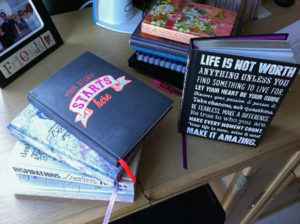By Samelia Bankole
Keeping a journal is still a thriving art. Graduate writing student, Shelley Danzy, is a proud journal writer who has several notebooks stacked up in her apartment. She began journal writing in elementary school. In an email interview Danzy said, “My parents gave me a

diary … a little green book with lock and key! Why? I guess the ‘reporter’ in me; the desire to not forget something.”
Danzy doesn’t have a concrete schedule for journaling. She prefers to write whenever she feels called to do so. As she says, “personal thoughts aren’t on a deadline.” She enjoys writing about her thoughts and experiences. Her inspirations are wide open. She writes about song lyrics, things people have said to her, and responses to what she reads. Her entries are sometimes revelations, questions and moments.
One of the revelations she noted in her journal is “Shelley, this is the day to start moving; start ridding of the junk; start filling, refueling and stop depleting and running on empty (which is an oxymoron in itself).”
Danzy’s love for journaling extends beyond the page. She attended writer Pearl Cleage’s “You are the Story” workshop at the Alliance Theatre in October 2014. The workshop focused on personal journal writing. In the workshop, Cleage said: “What historians tell you is what happened. What journals and art tell you is what it felt like to be there.” It inspired Danzy to do her best in writing about her experiences and the feelings she has about them. Danzy’s advice for journal writers is: “Be transparent and write freely. Don’t twist your thoughts in ways that make your imperfect life seem perfect.”
Other SCAD students also enjoy the craft of journaling. Aaron Tucker, a third-year student majoring in sequential art, journals about his dreams. In the morning he jots down as many details about the dream that he can remember.
Journaling began for Tucker in high school. He wrote in journals on and off and his inspiration were his dreams. First, he wrote his dreams only in physical journals and later he started posting his writing on Facebook. He still writes and sketches his dreams as a college student, but it is usually during school breaks.
One of his dreams was of him flipping through a sketchbook. He came across an illustration he did of trees and Tucker was so inspired by this image that he incorporated the ideas in a school project. The dreams that he writes down are usually ones that make a lasting impression on him.
For journal keepers, journaling has many personal benefits. For fourth-year interior design student, Van Dang, writing in journals helped her express feelings she had trouble sharing with others. She started writing in seventh grade. She said: “By that age, things started to get complicated, growing up. Teenagers have a lot of thoughts about self, family, career, love and relationships.”
During this time, writing about her thoughts and feelings helped her to better deal with life challenges in relationships and with her sense of self. “Journaling for me has evolved into speaking to myself. Journaling has been an encouragement to me. The things I write help me become a stronger self. It is a process of splitting myself into another person and I am encouraged by what I write. My journal is like a big sister to me,” Dang says.
For these SCAD students, journaling is a helpful process. The journal can be a source of strength, preserving memories and creativity. It can help people, especially artists, slow down and appreciate life’s amazing moments. Dang encourages people to write about ordinary experiences, like a poem they read or a movie they saw. You never know where your own personal writing may lead.





















